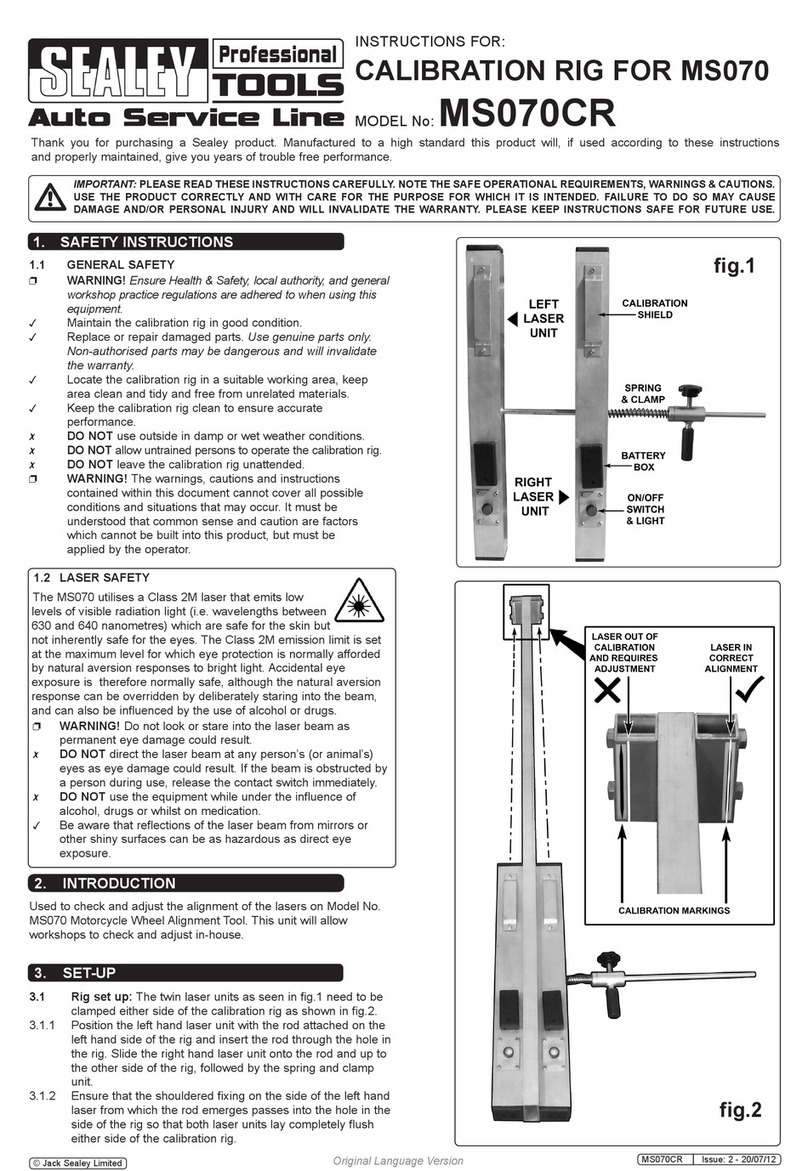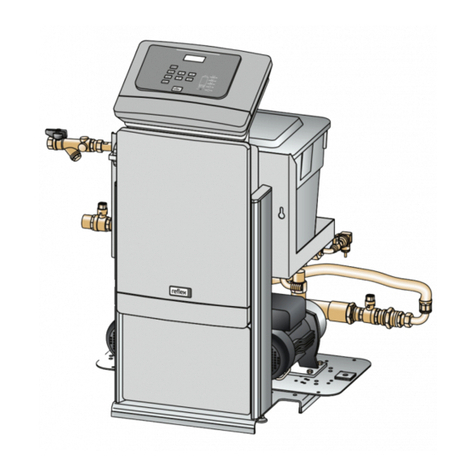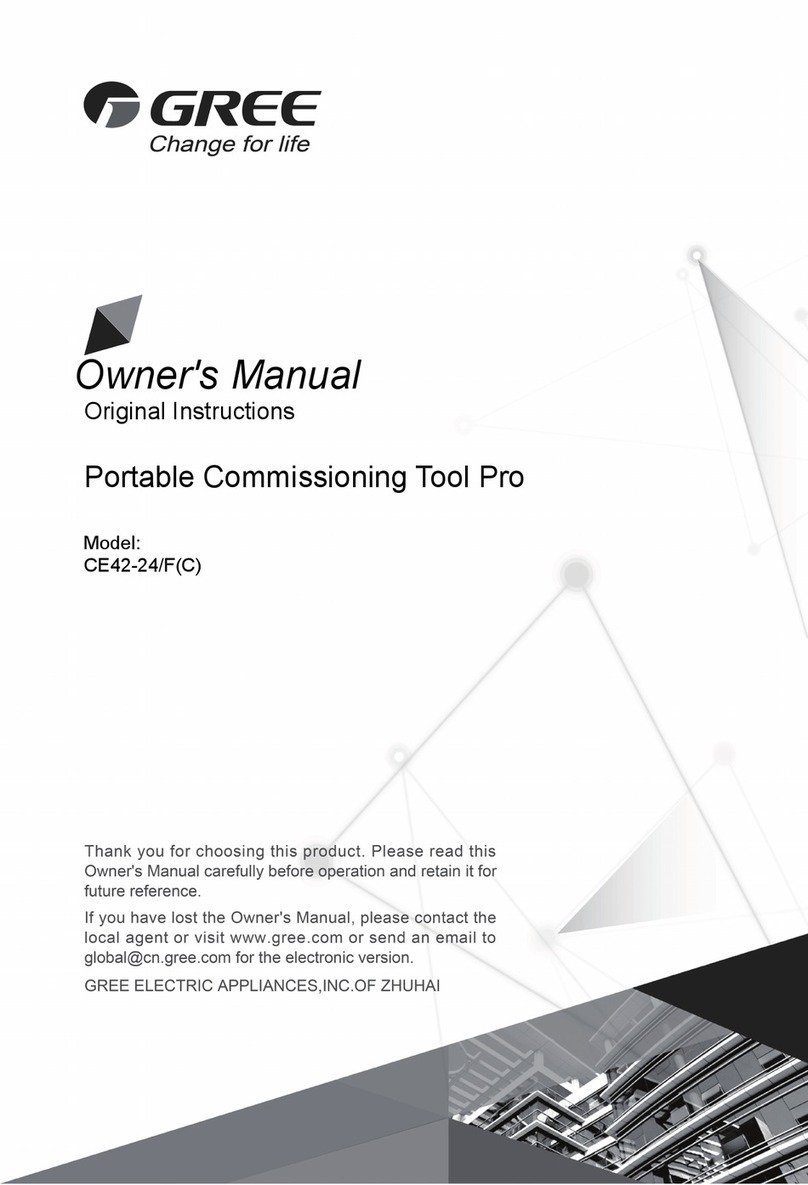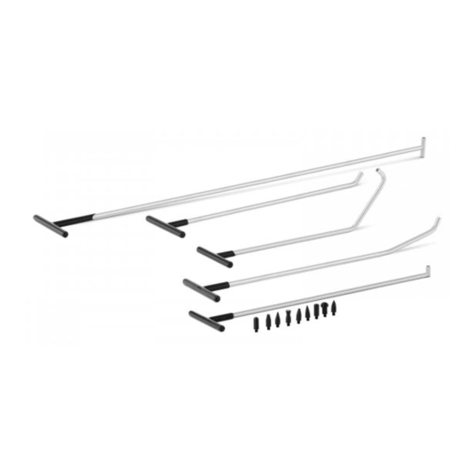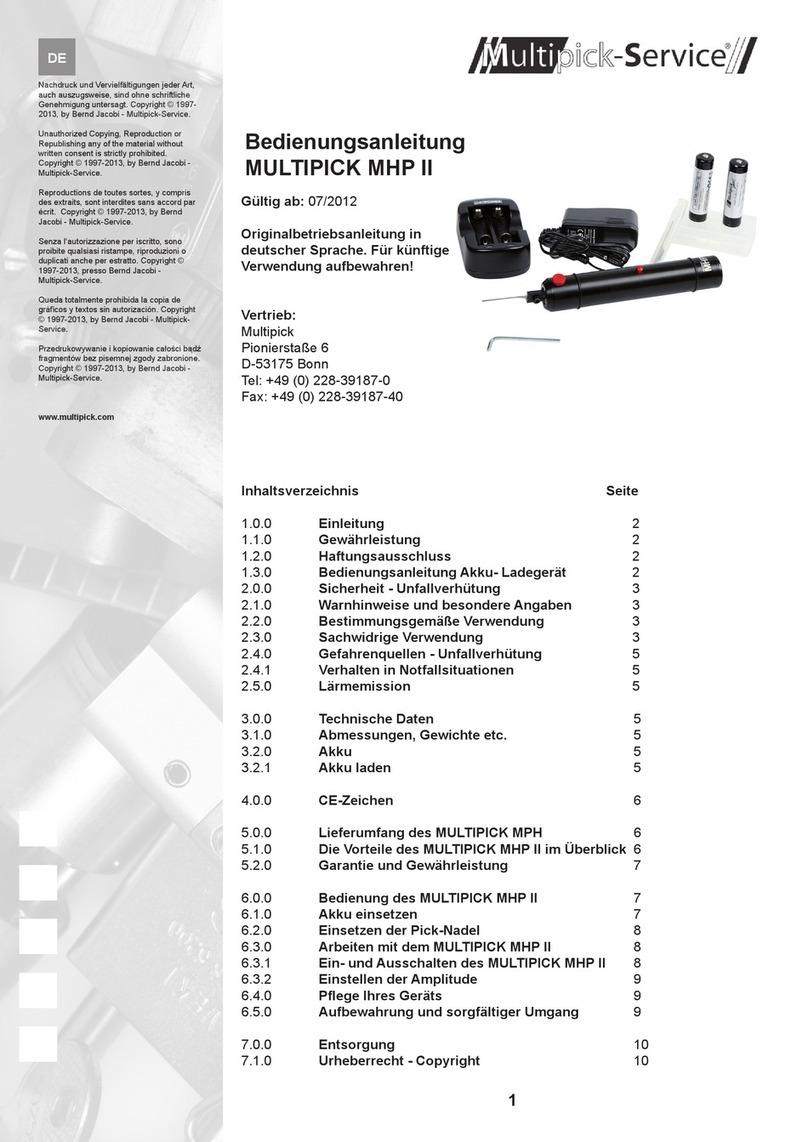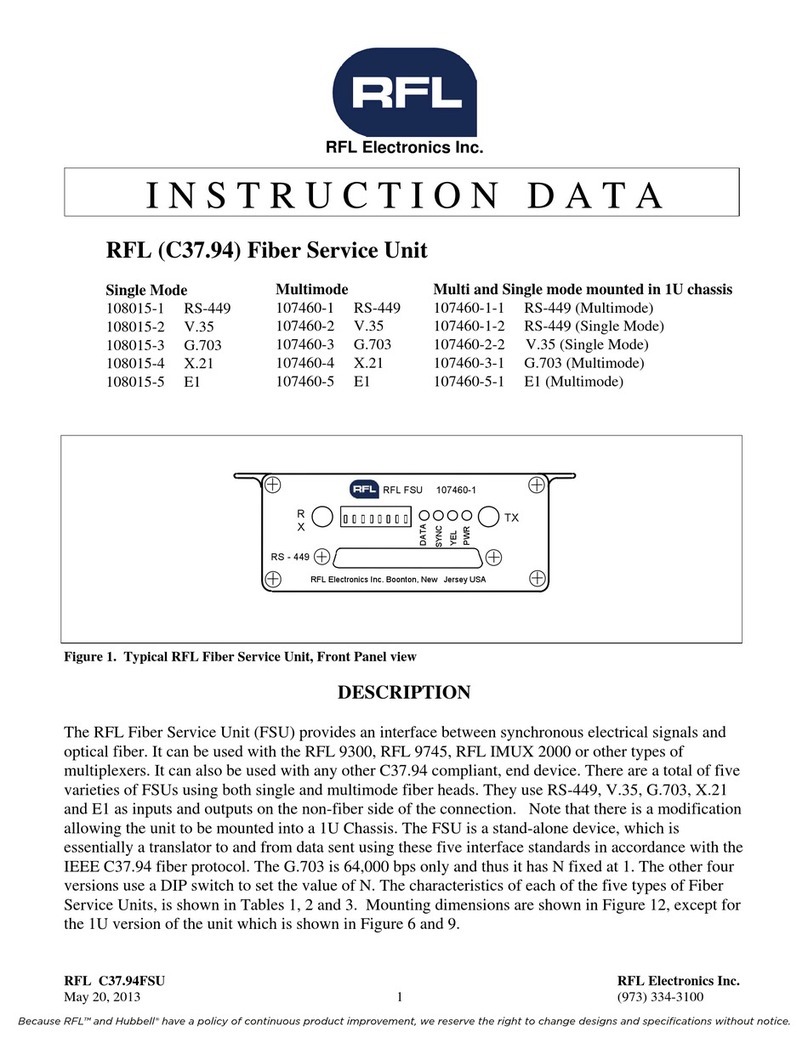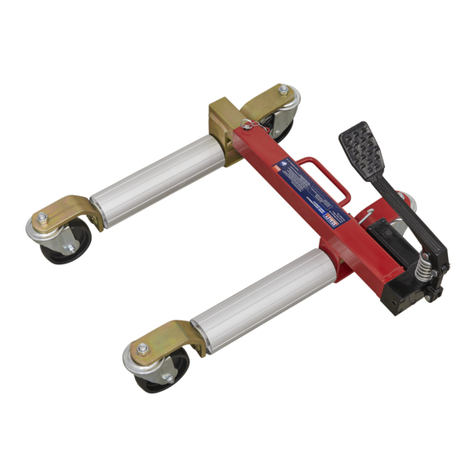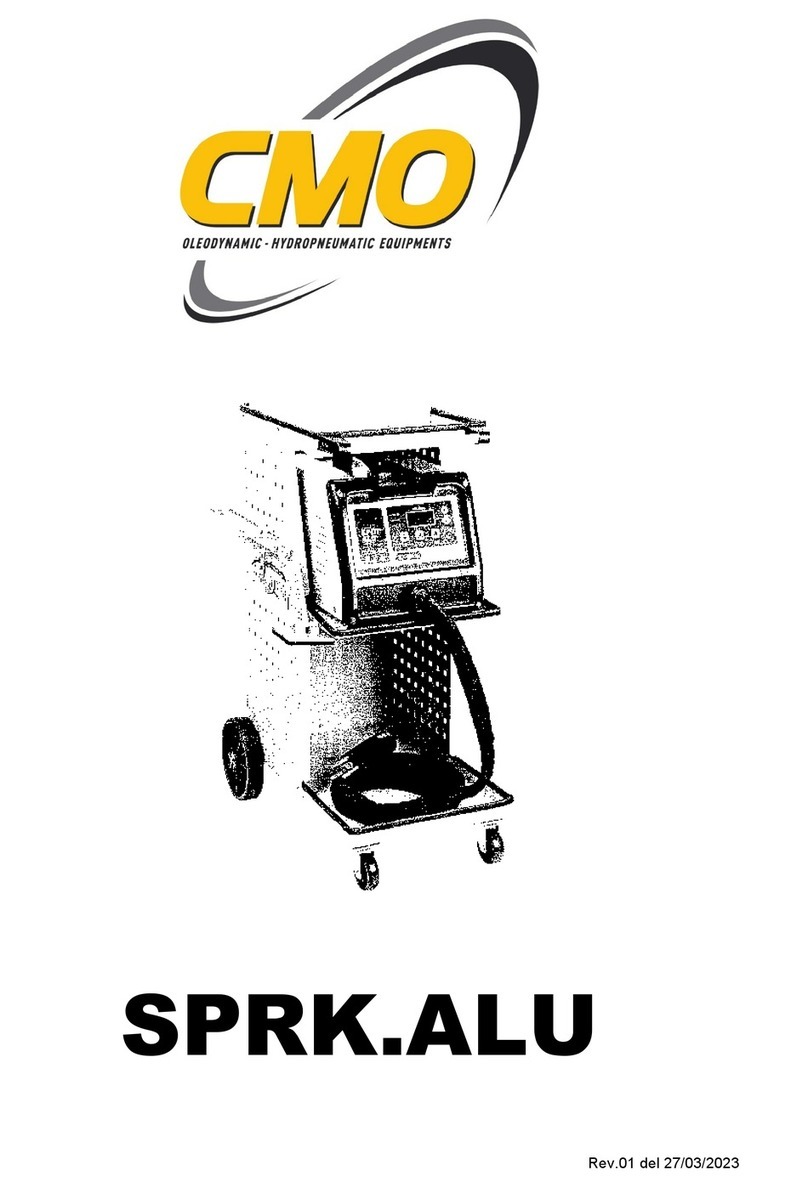Biomarine BioPak 240R SK240R User manual

Model SK240R
BioPak 240R Respirator, Service Kit
User Manual
Manual Part Number: B5-06-6900-16-0
Document Number: 47D538
Revision: A
ECO: 10001

Model SK240R Service Kit User Manual
Revision A 47D538
2
TABLE OF CONTENTS
I. Introduction 3
II. Service Kit Specifications 3
III. Tool Listing 4
IV. Service Kit Maintenance Procedures 5
A. Pressure Gauge Zero Check 5
B. Leak Testing 5
C. Leak Repair 5
V. BioPak 240R Service Procedures 7
A. Harness Replacement 7
B. Diaphragm Replacement 8
C. Feed Line Replacement 9
D. Manifold Assembly Replacement 10
E. Oxygen Feed Line Replacement 11
F. Bypass Valve Feed Line Replacement 11
G. Bypass Valve Return Line Replacement 12
H. Remote Gauge Feed Line Replacement 12
I. Pressure Regulator Assembly Replacement 13
J. Bypass Valve Assembly Replacement 13
K. Remote Gauge Quick Disconnect Valve Assembly Replacement 14
L. Vent Valve Replacement 15
M. Check Valve Replacement 16
VI. Illustrated Parts List 18

Model SK240R Service Kit User Manual
Revision A 47D538
3
I. INTRODUCTION
The BioPak 240R Model SK240R Service Kit will
provide the Benchman with the tools required for
normal service and maintenance of the BioPak 240R
respirator. All tools and fixtures are provided in a
water-proof, air-tight, light-weight polypropylene
case to provide maximum protection and portability
of all tools. The case also provides for the
installation of a lock (lock not included) for enhanced
tool protection.
This manual will provide a guide to the Benchman
for use of the service kit and will also provide
additional service procedures not covered in
standard BioPak 240R User or Benchman Manuals.
Additional resources, including diagrams and close
up pictures of components, can be obtained free of
charge from the Biomarine website at
www.BioPak240R.com under the Manuals & Tech
Info tab and downloading the training posters file.
Warning: The SK240R Service Kit is only intended
for use with the BioPak 240R respirator.
Warning: The SK240R Service Kit and this manual
are only for use by individuals certified as Biomarine
Benchman.
Warning: This manual does not replace the
required maintenance procedures provide in the
BioPak 240R User or Benchman Manuals. Benchman
must still refer to the BioPak 240R User and/or
Benchman Manuals for normal routine maintenance
procedures.
The Service kit is provided with a pressure test gauge
that will provide pressure measurements in the units
as listed below:
Service Kit
Part Number Pressure Units
B6-02-5002-16-0 “WC (0-10)
B6-02-5002-16-3 mbar (0-25)
II. SERVICE KIT SPECIFICATIONS
Case: Polypropylene
O-ring Sealed Lid
Water-Tight
Air-Tight
Lightweight
Lock Installation
Pressure Gauge, “WC Version:
Accuracy: +/- 2% Full Scale (+/- 0.20 “WC)
Range: 0-10 “WC
Minor Divisions: 0.2”WC
Temperature Limit: 20 to 140oF
-7 to 60oC
Pressure Limit: -20”Hg to 15 psig
-68 to 103 kPa
Overpressure: Relief plug opens at ~
25 psig, 172 kPa
Pressure Gauge, mbar Version:
Accuracy: +/- 2% Full Scale (+/- 0.50 mbar)
Range: 0-25 mbar
Minor Divisions: 0.5 mbar
Temperature Limit: 20 to 140oF
-7 to 60oC
Pressure Limit: -20”Hg to 15 psig
-68 to 103 kPa
Overpressure: Relief plug opens at ~
25 psig, 172 kPa
Flowmeter:
Accuracy: +/- 10% Full scale (+/- 0.46 lpm)
Range: 0.6 to 4.6 lpm
Minor Divisions: 0.2 lpm
Pressure Rating: 50 psi, 3.4 bar MAXIMUM
Temperature Rating: to 125oF MAXIMUM
to 52oC MAXIMUM

Model SK240R Service Kit User Manual
Revision A 47D538
4
III. Tool Listing
The following tools and fixtures are
provided with the Service Kit. Reference
the Illustrated Parts List to see depictions of
each tool.
B2-02-5400-04-0, Regulator Wash Plug
Uses: Provides pressure regulator inlet
port coverage during maintenance
cycles.
B2-03-1000-10-0, Combination Pick Tool
Uses: O-ring extraction.
B2-03-1000-22-0, 1/8” Slotted Screwdriver
Uses: Center section lid slide-lock
mounting screws.
B2-03-1000-01-0, 3/16” Slotted Screwdriver
Uses: Center section ¼-turn hold down
pins.
B2-03-1000-15-0, #00 Phillips Screwdriver
Uses: Remote sensor module battery
door screws.
B2-03-1000-03-0, #1 Phillips Screwdriver
Uses: Quick disconnect valve mounting
screws, Diaphragm guide plate
mounting screws, Demand valve
mounting screws.
B2-03-1000-16-0, #2 Phillips Screwdriver
Uses: Pressure regulator mounting
screws, Manifold mounting screws,
Harness mounting screws.
B2-03-1000-04-0, 3/8” x 5/16” Open End Wrench
Uses: Center section lid slide-lock
mounting rivet, Swivel elbow fitting
mounting stud, Swivel elbow fitting
tube nut, Center section demand
feed male connector fitting tube
nut.
B2-03-1000-05-0, 5/8” x 9/16” Open End Wrench
Uses: Center section demand port fitting.
B2-03-1000-06-0, 7/16” Combination Wrench
Uses: Remote monitor light guide fitting
nuts, Pressure regulator oxygen
feed line tube nut, Remote gauge
feed line tube nuts.
B2-03-1000-13-0, ½” Combination Wrench
Uses: Center section constant add port
fitting.
B2-03-1000-09-0, 3/16” Nut Driver
Uses: Demand valve mounting nuts, Quick
disconnect valve assembly
mounting nuts.
B2-03-1000-21-0, 9/32” Nut Driver
Uses: Breathing hose clamp nuts.
B2-03-1000-12-0, 5/16” Nut Driver
Uses: Center section slide-lock stud,
Diaphragm mounting clamp nut,
Swivel elbow fitting mounting stud.
B2-03-1000-17-0, ¼” Hex Driver
Uses: Constant ad flow restrictor
assembly.
B2-03-1000-20-0, Stopwatch
Uses: Test timing.
B2-03-3000-01-0, Vent Valve Wrench
Uses: Vent valve disassembly.
B2-06-6002-60-0, Demand Port Wash Plug
Uses: Center section demand port fitting
wash plug.
B5-01-3000-03-0, Leak-Tec
Uses: Detection of leaking joints or
connections.
B6-02-5000-17-2, Test Key
Uses: Vent valve isolation during leak
testing.
B6-02-5002-15-0, Flow Test Fixture
Uses: Constant add flow detection.
B6-02-5003-00-0, Leak Check Adapter
Uses: BioPak connection to service kit.

Model SK240R Service Kit User Manual
Revision A 47D538
5
IV. SERVICE KIT MAINTENANCE
PROCEDURES
A. Pressure Zero Calibration
The service kit pressure gauge should be
periodically checked for zero calibration and
adjusted if necessary.
1. Place the service kit on a flat and level
surface.
2. Verify that the service kit input port is open
and the bleed valve is open.
3. Verify that the pressure gauge reads zero
(0) pressure. If the gauge does not read
zero pressure, use a 1/8” slotted
screwdriver to adjust the zero screw of the
pressure gauge until zero (0) pressure is
indicated on the dial of the pressure gauge.
B. Leak Testing
The service kit plumbing should be leak tested a
minimum of once every six-to twelve (6-12)
months.
1. Place the service kit on a flat and level
surface.
2. Verify that the service kit bleed valve is in
the closed position.
3. Supply a clean, dry pressure source to the
input port of the service kit and pressurize
the service kit to 10”WC or 25 mbar.
4. Close the pressure source to the service kit.
5. Observe the service kit pressure gauge and
start the stopwatch.
6. The pressure gauge of the service kit shall
not drop in pressure reading over a two (2)
minute period.
7. Open the service bleed valve to vent
pressure and remove the pressure source.
C. Leak Repair
If the service kit fails leak testing, the leak shall
be located and repaired.
1. Use a slotted screwdriver to pry open the
four (4) plastic screw covers on the
perimeter of the service kit top panel.
2. Use a #1 phillips screwdriver to remove the
four panel mounting screws.
3. Lift the top panel out of the service kit case.
4. Verify that the bleed valve of the top panel
is in the closed position and apply a clean,
dry pressure source to the input port of the
panel.

Model SK240R Service Kit User Manual
Revision A 47D538
6
5. Pressurize the top panel until the pressure
gauge reads 10”WC or 25 mbar.
6. Apply Leak-Tec fluid to all tubing joints,
threaded connections and valve stem.
7. Allow the Leak-Tec to sit undisturbed for 1-
2 minutes then check all locations for the
formation of bubbles. The formation of
bubbles will indicate a leak position.
8. Correct the leak by tightening the leaking
joint, through component replacement or
through factory service.
9. Test the repaired top panel assembly for
leaks as per the Leak Testing procedure.
10. If the top panel passes the leak test, dry the
assembly of all Leak-Tec fluid and reposition
back into the case.
11. Secure the panel into the case using the
four screws and screw covers removed in
steps 1 and 2. Do over-tighten and strip
the screws.

Model SK240R Service Kit User Manual
Revision A 47D538
7
V. BioPak 240R Service Procedures
Warning: All procedures are to be conducted
with the BioPak fully vented of all pressure and the
oxygen cylinder removed. Cover the inlet port of the
pressure regulator with the Regulator Wash Plug
during all service operations. It is imperative that all
service procedures be followed by Turn-Around
Maintenance as described in the BioPak 240R User
and/or Benchman Manuals.
Most procedures are more easily made if the BioPak
is propped in a level position as depicted below. This
also lessens strain and stress on the lower housing
during center section lid installation.
A. Harness Replacement
Required Tools:
➢#2 Phillips Screwdriver
1. Place the BioPak on a flat and level surface
so it is resting on the upper housing.
2. Locate and remove the eight sets of screws
and washers or four sets of mounting plates
securing the harness.
3. Remove the old harness and handle from
the BioPak.
4. Verify that the regulator support plate is in
place on the harness mounting location
direct beneath the pressure regulator.
Note: If the harness is mounted with plate
assemblies, the regulator support plate
is not utilized.
5. Position the waist belt of the new harness
onto the lower mounting locations of the
BioPak.
6. Secure the waist belt to the BioPak using
two long harness mounting screws and two
washers in the location where the regulator
support plate is located, and two short
harness screws and washers in the
remaining location. For harnesses mounted
with plates, utilize the two plates marked
“W” to mount the waist belt.
7. Position the carrying handle and shoulder
straps of the harness onto the upper
mounting location of the BioPak.
8. Secure the harness and carrying handle to
BioPak using four long screws and washers.
Note that the shoulder harness has multiple
mounting eyelets to provide size
adjustment when mounting. For harnesses
mounted with plates, utilize the plates
marked “S” to mount the handle and
shoulder harnesses.

Model SK240R Service Kit User Manual
Revision A 47D538
8
B. Diaphragm Replacement
Required Tools:
➢5/16” Nut Driver
➢9/32” Nut Driver
➢3/16” Slotted Screwdriver (optional)
1. Use the 9/32” nut driver to loosen the
breathing hose clamps and remove the
breathing hoses from the center section
and center section lid.
2. Remove the center section lid by sliding all
eight (8) slide –lock clips to the open
position and pulling the lid from the center
section.
3. Remove the PCM (if present), carbon
dioxide scrubbers (if present) and the
moisture control sponge set for the center
section.
4. Disconnect the constant add feed line,
demand add feed line and the temperature
cable from the center section.
5. Use a 3/16” slotted screwdriver or hand to
remove the four (4) ¼-turn center section
pins.
6. Lift the center section straight up and out of
the BioPak lower housing. Place the center
section on a clean and level surface with the
diaphragm exposed.
7. Use the 5/16” nut driver to loosen and
remove the diaphragm clamp.
8. Remove the diaphragm from the center
section.
Note: This procedure assumes replacement
of the complete diaphragm assembly.
Refer to Section V. L. if the vent valve
of the replaced diaphragm is being
reused.
9. Install the new diaphragm assembly into the
well of the center section making sure to position
the diaphragm exactly as depicted below. Verify
that the diaphragm edge is fully seated against
exterior center section shoulder.
10. Install the diaphragm clamp over the
diaphragm edge and position exactly as
depicted above. Secure the clamp using
the 5/16” nut driver.
11. Install the center section into the lower
housing of the BioPak making sure to
properly locate the open end of each of the
three springs around the large projections
of the diaphragm support plate.
12. Secure the center section into position
using the four (4) ¼-turn pins. It may be
necessary to squeeze the center section
mounting ear and lower housing together in
order for the pins to engage.
13. Reconnect the temperature cable, demand
add feed line and constant add feed line to
the center section.

Model SK240R Service Kit User Manual
Revision A 47D538
9
B. Diaphragm Replacement (continued)
14. Reinstall the moisture control sponge set,
PCM (if present) and new carbon dioxide
scrubbers (if present) back into the center
section.
Note: It is anticipated that carbon dioxide
scrubber will run the risk of drying out
while exposed to ambient atmospheres
during this procedure so it is strongly
suggested that they be exchanged with
fresh scrubbers.
15. Position the center section lid onto the
center section and verify that all slide-locks
are in the open position. Install the lid by
pushing it straight down onto the center
section and secure by closing all eight slide-
lock clips.
16. Reinstall the breathing hoses to the center
section using the 9/32” nut driver to tighten
hose clamps. Verify that the mask
connection piece is properly positioned
with the arrows up and directed left to
right.
C. Feed Line Replacement
Required Tools:
➢3/8” x 5/16” Open End Wrench or
5/16” Nut Driver
➢Cutting Dikes (not provided in
service kit)
➢Pliers or Cable Tie Gun (not provided
in service kit)
1. Disconnect the constant add feed line
(green) and/or disconnect the demand add
feed line (red) from the center section port.
2. Carefully, cut the three (3) plastic cable ties
that bundle the feed line with other feed
lines and electrical cables.
Warning: Do not cut or nick any of the electrical
cables or pneumatic lines bundled by the cable ties.
3. Use the 5/16” nut driver or 5/16” open end
wrench to unthread and remove the
constant add feed line and/or the demand
add feed line from the manifold assembly.
4. Verify that o-rings of the swivel elbow are
properly positioned and use the 5/16” nut
driver or 5/16” open end wrench to install a
new constant add feed line and/or a new
demand add feed line into the manifold
assembly.
5. Route the feed line across the bottom of
the lower housing and connect to the
constant add feed port (green) and/or the
demand add feed port (red) of the center
section.
6. Use three (3) replacement cable ties to
bundle all feed lines and electrical cables
together. Pull the cable tie tight with pliers
or a cable tie gun and trim away the
resultant tail.
Warning: Verify that the cut tail of the cable tie
does not contact the rubber diaphragm.

Model SK240R Service Kit User Manual
Revision A 47D538
10
D. Manifold Assembly Replacement
Required Tools:
➢3/8” x 5/16” Open End Wrench or
5/16” Nut Driver
➢¼” Hex Driver
➢#2 Phillips Screwdriver
➢Cutting Dikes (not provided in
service kit)
➢Pliers or Cable Tie Gun (not provided
in service kit)
1. If the flow restrictor is to be reutilized from
the current manifold assembly, use the ¼”
hex driver to remove it and the head gasket
from the manifold assembly as described by
the BioPak 240R Benchman Manual.
2. Use the 5/16” open end wrench or the
5/16” nut driver to remove all swivel elbow
connections from the manifold assembly.
Do not loosen the tube nuts of these
fittings during removal.
3. Cut the three (3) plastic cable ties that
bundle the feed lines and electrical cables.
Warning: Do not cut or nick any of the electrical
cables or pneumatic lines bundled by the cable ties.
4. Disconnect the electrical connection from
the remote sensor module labeled
“MANIFOLD”. Disconnection is made by
fully unthreading the connector and pulling
straight up and out of the module socket.
5. Use the #2 phillips screwdriver to remove
the two (2) mounting screws and washers
from the exterior side of the lower housing
that secure the manifold into position.
6. Remove the manifold assembly from the
BioPak.
7. Position a new manifold into the BioPak and
secure using the two (2) mounting screws
and washers installed from the exterior side
of the lower housing.
8. Route the electrical cable from the manifold
assembly across the lower housing and
connect to the remote sensor module port
labeled “MANIFOLD”. Connection is made
by aligning the cable at a 30odegree angle
and pressing into the socket then fully
threading the cable connector onto the
socket.
9. Use the 5/16” open end wrench or the
5/16” nut driver to reinstall all swivel elbow
connections to the manifold assembly. Do
not loosen the tube nuts of these fittings
during removal. Verify that all swivel
elbow o-rings are properly positioned prior
to reinstallation back into the manifold
assembly. Pneumatic line connection
locations are as follows:
10. Use three (3) replacement cable ties to
bundle all feed lines and electrical cables
together. Pull the cable tie tight with pliers
or a cable tie gun and trim away the
resultant tail.
Warning: Verify that the cut tail of the cable tie
does not contact the rubber diaphragm.
11. Use the ¼” hex driver to reinstall the flow
restrictor into the manifold as directed by
the BioPak 240R Benchman Manual.

Model SK240R Service Kit User Manual
Revision A 47D538
11
E. Oxygen Feed Line Replacement
Required Tools:
➢5/16” Nut Driver
➢7/16” Combination Wrench
1. Use the 7/16” combination wrench to
unthread the oxygen feed line tube nut
from the pressure regulator.
2. Use the 5/16” nut driver to remove oxygen
feed line swivel elbow connector from the
top of the manifold assembly.
3. Install a new oxygen feed line to the
pressure regulator using the 7/16”
combination wrench to tighten the tube nut
1-1/4 turns past finger-tight.
4. Verify that o-rings of the swivel elbow are
properly positioned and install the fitting in
to the top of the manifold assembly using
the 5/16” nut driver.
F. Bypass Feed Line Replacement
Required Tools:
➢3/8” x 5/16” Open End Wrench
➢5/16” Nut Driver
1. Use the 5/16” open end wrench to remove
the swivel elbow fitting of the bypass feed
line from the top side port of the manifold.
2. Use the 5/16” open end wrench or 5/16”
nut driver to remove the swivel elbow
fitting from the top port of the bypass
valve.
3. Verify that o-rings of the swivel elbow are
properly positioned and install the new
bypass feed line between the bypass valve
and manifold routing the tube just as the
removed tube was routed.
4. Tighten the swivel elbow fittings using the
5/16” open end wrench and/or the 5/16”
nut driver.

Model SK240R Service Kit User Manual
Revision A 47D538
12
G. Bypass Return Line Replacement
Required Tools:
➢3/8” x 5/16” Open End Wrench
➢5/16” Nut Driver
1. Use the 5/16” open end wrench to remove
the swivel elbow fitting of the bypass feed
line from the bottom side port of the
manifold. Do not remove the extension
fitting from the manifold.
2. Use the 5/16” open end wrench or 5/16”
nut driver to remove the swivel elbow
fitting from the side port of the bypass
valve.
3. Verify that o-rings of the swivel elbow are
properly positioned and install the new
bypass feed line between the bypass valve
and manifold routing the tube just as the
removed tube was routed.
4. Tighten the swivel elbow fittings using the
5/16” open end wrench and/or the 5/16”
nut driver.
H. Remote Gauge Feed Line Replacement
Required Tools:
➢7/16” Combination Wrench
➢Cutting Dikes (not provided in
service kit)
➢Pliers or Cable Tie Gun (not provided
in service kit)
1. Use the 7/16” combination wrench to
disconnect the tube nuts of the remote
gage feed line (copper line) from the
pressure regulator assembly and the
remote gauge quick disconnect valve
assembly.
2. Cut the three (3) plastic cable ties that
bundle the feed lines and electrical cables.
Warning: Do not cut or nick any of the electrical
cables or pneumatic lines bundled by the cable ties.
3. Remove the remote gauge feed line from
the BioPak.
4. Position the new remote gauge feed line
into the BioPak and finger-tighten the tube
nuts.
5. Finish the tube nut installation by wrench-
tightening each nut 1-1/4 turns past finger-
tight using the 7/16” combination wrench.
6. Use three (3) replacement cable ties to
bundle all feed lines and electrical cables
together. Pull the cable tie tight with pliers
or a cable tie gun and trim away the
resultant tail.
Warning: Verify that the cut tail of the cable tie
does not contact the rubber diaphragm.

Model SK240R Service Kit User Manual
Revision A 47D538
13
I. Pressure Regulator Assembly
Replacement
Required Tools:
➢7/16” Combination Wrench
➢#2 Phillips Screwdriver
➢Cutting Dikes (not provided in
service kit)
➢Pliers or Cable Tie Gun (not provided
in service kit)
1. Cut the three (3) plastic cable ties that
bundle the feed line with other feed lines
and electrical cables).
Warning: Do not cut or nick any of the electrical
cables or pneumatic lines bundled by the cable ties.
2. Disconnect the electrical connection from
the remote sensor module labeled
“REGULATOR”. Disconnection is made by
fully unthreading the connector and pulling
straight up and out of the module socket.
3. Disconnect the remote gauge feed line and
oxygen feed line tube nuts from the
pressure regulator assembly using the
7/16” combination wrench.
4. Use the #2 phillips screwdriver to remove
the two (2) mounting screws and washers
from the regulator assembly.
5. Remove the oxygen knob retaining bracket
from the top of the pressure regulator
mounting bracket and remove the regulator
assembly.
6. Position a new pressure regulator assembly
and the oxygen knob retaining bracket into
the BioPak and secure with the two (2)
mounting screws and washers.
7. Use the 7/16” combination wrench to
reinstall the tube nuts of the remote gauge
feed line and oxygen feed line 1-1/4 turns
past finger tight.
8. Route the electrical cable from the manifold
assembly across the blower housing and
connect to the remote sensor module port
labeled “REGULATOR”. Connection is made by
aligning the cable at a 30odegree angle and
pressing into the socket then fully threading the
cable connector onto the socket.
9. Use three (3) replacement cable ties to bundle
all feed lines and electrical cables together. Pull
the cable tie tight with pliers or a cable tie gun
and trim away the resultant tail.
Warning: Verify that the cut tail of the cable tie
does not contact the rubber diaphragm.
J. Bypass Valve Assembly Replacement
Required Tools:
➢3/8” x 5/16” Open End Wrench
➢5/16” Nut Driver
➢Bypass Valve Tool, B2-03-3000-08-0
(not supplied in service kit)
1. Use the 5/16” open end wrench and/or the
5/16” nut driver to remove the swivel
elbows of the bypass feed and bypass
return lines from the bypass valve
assembly.
2. Note the valve positioning and use the
bypass valve tool to unthread the bypass
valve assembly retaining nut located on the
interior surface of the lower housing.
3. Remove the bypass valve assembly.

Model SK240R Service Kit User Manual
Revision A 47D538
14
J. Bypass Valve Assembly Replacement
(continued)
4. Position a new bypass valve assembly into
the lower housing in the same position as
the prior valve and secure by fully
threading the retaining nut onto the
assembly and against the interior surface of
the lower housing using the bypass valve
tool.
5. Verify that o-rings of the swivel elbows are
properly positioned and install elbows of
the bypass feed line to the top port of the
bypass valve assembly and the bypass
return line to the side port of the bypass
valve assembly using the 5/16” open end
wrench and/or the 5/16” nut driver.
K. Remote Gauge Quick Disconnect Valve
Assembly Replacement
Required Tools:
➢7/16” Combination Wrench
➢#1 Phillips screwdriver
➢3/16” Nut Driver
1. Pull up on the coupler of the quick
disconnect fitting to release the external
remote gauge assembly.
2. Disconnect the temperature sensor cable
from the remote sensor module and pull
the remote sensor module up and out of
the BioPak to allow access to the quick
disconnect valve assembly.
3. Use the 7/16” combination wrench to
disconnect the tube nut of the remote
gauge feed line from the valve assembly.
4. Use the 3/16 nut driver and #1 phillips
screwdriver to remove the two(2) sets of
mounting screws, washers and nuts from
the quick disconnect valve assembly
mounting bracket.
5. Slide the mounting bracket up and out of
the BioPak and remove the valve assembly.
6. Position the new valve assembly into
position within the BioPak and slide the
mounting bracket into position.
7. Loosely secure the mounting bracket using
the two (2) sets of mounting hardware but
do not fully tighten at this time.
8. Connect the remote gauge feed line tube
nut to the valve assembly 1-1/4 turns past
finger-tight using the 7/16” combination
wrench.
9. Final position the valve assembly in the
BioPak and fully tighten the mounting
hardware of the mounting bracket.
10. Reposition the remote sensor module into
the BioPak and reconnect the temperature
cable.
11. Install the external remote gauge line into
the coupler of the valve assembly.

Model SK240R Service Kit User Manual
Revision A 47D538
15
L. Vent Valve Replacement
Required Tools:
➢Vent Valve Wrench
➢Molykote-111 Lubricant, B5-01-
3000-11-0 (not supplied in Service
Kit but is supplied in Seal and Lube
Kit)
Note: Follow the procedures of section V. B.
for removal and reinstallation of the
diaphragm assembly. The vent valve
assembly cannot be removed unless
the diaphragm has been removed from
the center section.
1. Use the vent vale wrench to unthread the
vent body from the vent cap.
2. Carefully remove the components from the
diaphragm assembly. The components will
include:
(1) Vent Body, B2-02-4100-03-0
(1) Vent Cap, B2-02-0000-08-0
(1) Vent Seat, B2-02-4000-89-1
(1) Vent Spring, B2-06-6001-53-0
(1) Large O-Ring, B4-04-7060-05-1
(1) Small O-Ring, B4-04-7060-04-1
3. Lubricate the o-rings of the new assembly
with Molykote-111 lubricate.
4. Install the lubricated small o-ring into the
dovetail gland of the vent seat. Make sure
the o-ring is fully seated by pressing it fully
into the dovetail gland.
5. Install the lubricated large o-ring into the
gland of the vent body.
6. Position the vent cap into the center
through hole of the diaphragm assembly.
The flange of the cap shall be located on the
rubber side of the diaphragm assembly.
7. Place a small amount of Molykote-111
lubricant into the central cavity of the vent
seat. This lubricant will be utilized to help
adhere the spring to the cap for easier vent
valve assembly.
8. Position the vent spring into the cavity of
the vent seat and position in the center of
the vent cap in the diaphragm assembly.
9. Secure the vent valve into position by hand-
threading the vent body onto the vent cap
pinching the diaphragm assembly between
the two components.
10. Verify that the vent seat can fully actuate
and is centered within the valve assembly.
Warning: The vent valve assembly shall be
tightened to hand-tight only. Do not utilize any
tools to tighten the components and do not
over-tighten the assembly. Over-tightening of
the vent valve component could cause damage
to the diaphragm assembly.

Model SK240R Service Kit User Manual
Revision A 47D538
16
M. Check Valve Replacement
Note: Check valve replacement in the
facemask connector is difficult and
extremely rare. Replacement is not
advised unless first discussing the
procedure with the Biomarine factory
or an Authorized Biomarine
representative.
Required Tools:
➢Clean, Long Needle Nose Pliers (not
included in Service Kit)
➢9/32” Nut Driver (if breathing hoses
are connected to facemask
connector via worm gear clamps)
➢Ratchet Pincers, B2-03-1000-11-0 (if
breathing hoses are connected to
facemask connector via stepless ear
clamps-not included in service kit)
➢Flat Blade Screwdriver
➢Side Cutting Dikes
1. Use the appropriate tool to remove the
breathing hoses from the facemask
connector piece.
Worm Gear Connected Hoses: Use the
9/32” nut driver to loosen the hose clamps.
Stepless Ear Clamp Connected Hoses: Use
a flat blade screwdriver to carefully pry the
end of the clamp strap up enough so that
the end can be grabbed by side cutting
dikes. Grab the end of the strap of the
strap and carefully roll the strap away from
the hose and the clamp holding tangs until
the clamp releases. Once removed,
stepless ear clamps cannot be reused and
must be replaced with new clamps.
2. Remove the sealing cap from the facemask
connector if installed.
3. Use the needle nose pliers to reach in
through the exhalation port of the facemask
connector and grab the white check valve.
Pull the check valve out through the
exhalation port. Verify that the entire
check valve has been extracted and that no
pieces of the small diameter tail have
broken off and remained within the
facemask connector.
4. Use the needle nose pliers to reach in
through the small central port of the
facemask connector and grab the white
check valve. Pull the check valve out
through the central port. Verify that the
entire check valve has been extracted and
that no pieces of the small diameter tail
have broken off and remained within the
facemask connector.
5. Exhalation Side Check Valve Installation:
Position the small diameter tail of the check
valve into the center through hole of the
exhalation check valve holder from the
exhalation port of the facemask connector.
Use long needle nose pliers to pull the tail
of the check valve through the holder from
the central port of the facemask connect
until the shoulder of the tail snaps into
position against the internal side of the
holder. Do not allow the thin, large
diameter of the check valve to become
pulled through check valve holder. If the
check valve large diameter is pulled into
the check valve holder, the check valve will
become damaged and will need to be
replaced. After installation, rotate the
check valve in place to verify that it is not
impeded.

Model SK240R Service Kit User Manual
Revision A 47D538
17
M. Check Valve Replacement (continued)
6. Inhalation Side Check Valve Installation:
Use long needle nose pliers to position the
small diameter tail of the check valve into
the center through hole of the inhalation
check valve holder from the central port of
the facemask connector. Use long needle
nose pliers to pull the tail of the check valve
through the holder from the inhalation port
of the facemask connect until the shoulder
of the tail snaps into position against the
external side of the holder. Do not allow
the thin, large diameter of the check valve
to become pulled through check valve
holder. If the check valve large diameter is
pulled into the check valve holder, the
check valve will become damaged and will
need to be replaced. After installation,
rotate the check valve in place to verify that
it is not impeded.
7. Reposition the breathing hoses onto the
facemask connector and verify proper
orientation of the facemask connect so that
the arrows are directed up and pointing left
to right (from inhalation to exhalation).
8. Secure the hoses with the hose clamps
using the appropriate tool:
Worm Gear Connected Hoses: Use the
9/32” nut drive to tighten the hose clamps.
Stepless Ear Clamp Connected Hoses: Use
the ratchet pincers to secure the clamp.

Model SK240R Service Kit User Manual
Revision A 47D538
18
VI. Illustrated Parts List
ITEM # QTY. PART NUMBER DESCRIPTION
REF -- B6-02-5002-16-0 Service Kit-Complete-“WC
REF -- B6-02-5002-16-3 Service Kit-Complete-mbar
1a 1 B6-02-5002-57-0 Replacement Case Assembly-“WC1
1b 1 B6-02-5002-57-1 Replacement Case Assembly-mbar1
2 1 B6-02-5003-00-0 PRO Flow Test Fixture
3 1 B6-02-5002-15-0 Flow Test Fixture
4 2 B6-02-5000-17-2 Test Key
5 1 B2-03-3000-01-0 Vent Valve Hand Wrench
6 8 B2-06-6002-60-0 Demand Port Wash Plug
7 1 B2-02-5400-04-0 Regulator Wash Plug
8 1 B2-03-1000-10-0 Combination Pick Tool
9 1 B2-03-1000-15-0 #00 Phillips Screwdriver
10 1 B2-03-1000-03-0 #1 Phillips Screwdriver
11 1 B2-03-1000-16-0 #2 Phillips Screwdriver
12 1 B2-03-1000-17-0 ¼” Hex Driver
13 1 B2-03-1000-09-0 3/16” Nut Driver
14 1 B2-03-1000-12-0 5/16” Nut Driver
15 2 B2-03-1000-04-0 3/8” x 5/16” Open End Wrench
16 2 B2-03-1000-06-0 7/16” Combination Wrench
17 1 B2-03-1000-13-0 ½” Combination Wrench
18 1 B2-03-1000-05-0 5/8” x 9/16” Open End Wrench
19 1 B5-01-3000-03-0 Oxygen Safe Leak Detection Fluid, 8 ounces
20 1 B2-02-7001-28-0 Tool Pouch
21 1 B4-02-6037-00-0 Rubber Tubing2
22 1 B2-03-1000-20-0 Stop Watch
23 opt. B2-03-3000-08-0 Bypass Valve Tool3
24 1 B2-03-1000-21-0 9/32”Nut Driver
25 1 B2-03-1000-22-0 1/8” Slotted Screwdriver
26 1 B2-03-1000-01-0 3/16” Slotted Screwdriver
27 1 B5-06-6900-16-0 User Manual
Note:
1. Replacement Case Assembly, item 1, includes the tool kit case complete with internal pressure gauge and associated
plumbing plus external shipping box.
2. Order a minimum length of 6-feet of tubing. Longer lengths are available upon request.
3. The Bypass Valve Tool, item 23, is not supplied with the Service Kit. The tool is utilized for installation and removal of the
entire bypass valve assembly.

Model SK240R Service Kit User Manual
Revision A 47D538
19
Table of contents
Popular Service Equipment manuals by other brands
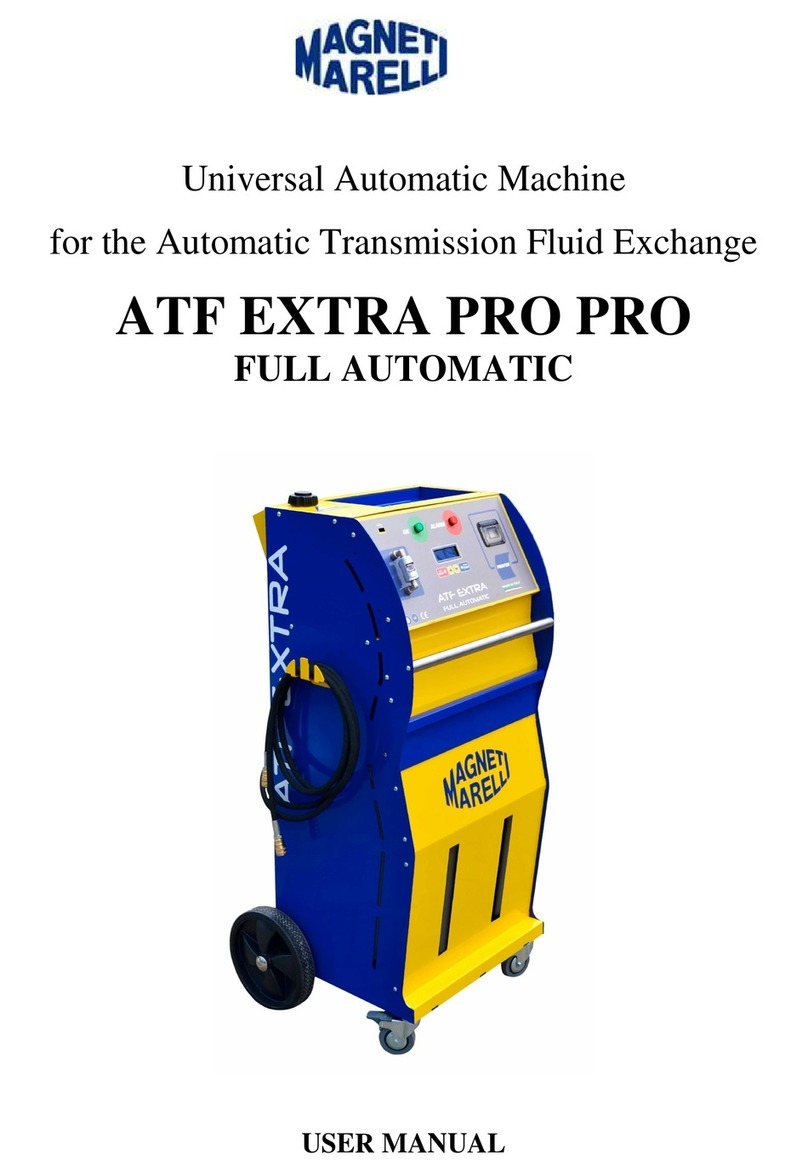
Magneti Marelli
Magneti Marelli ATF EXTRA PRO user manual
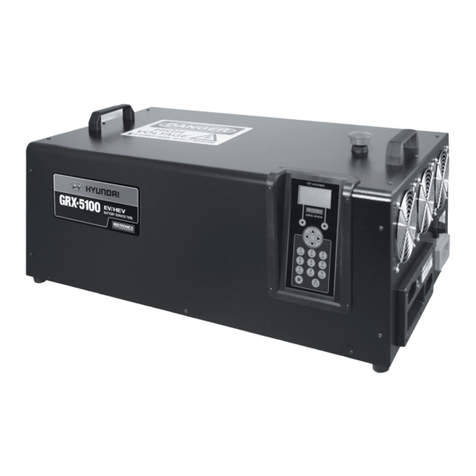
Hyundai
Hyundai Midtronics GRX-5100 instruction manual

Tronair
Tronair 01-1229-0011 Operation & service manual
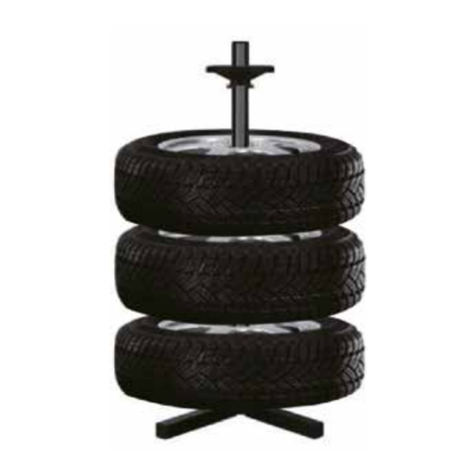
ULTIMATE SPEED
ULTIMATE SPEED HG02236 Assembly and Safety Advice
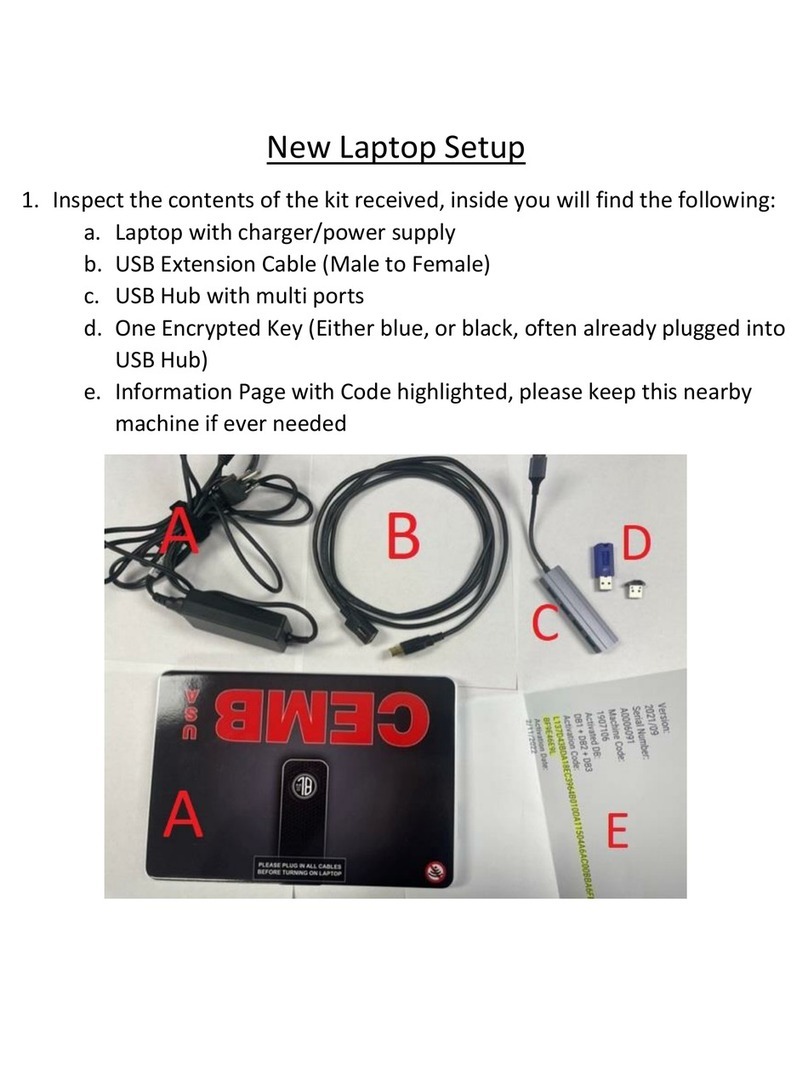
CEMB
CEMB DWA1000CWAS manual
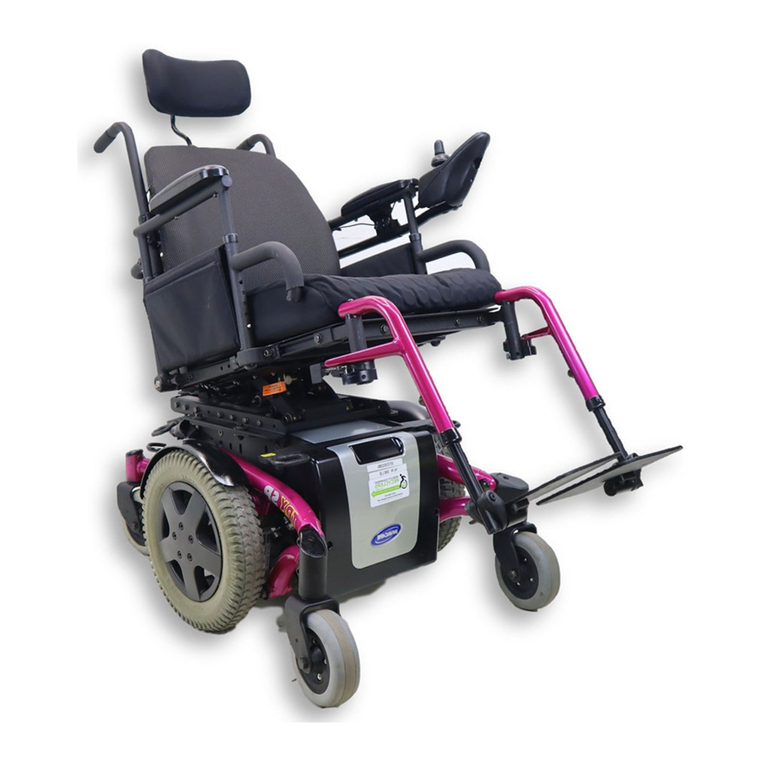
Invacare
Invacare TDX SP Assembly, installation and operating instructions


